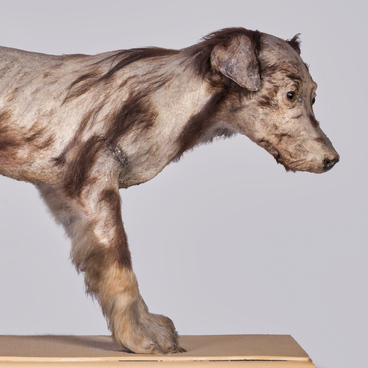The evolution of the horse’s hoof is well traced due to lots of the remained fossils and has therefore been studied in detail. This process lasted for about 50 million years: animals sought to adapt as much as possible to run fast on hard ground.
The first horses appeared in North America and after migrations, they spread across South America and Eurasia. Researchers speculate that they may have moved there across the land bridge located at the site of the present-day Bering Strait. In the process of evolution, horses became larger and developed hooves.
The earliest member of the horse family is thought to be the hyracotherium, which appeared about 50 million years ago. The legs of these small animals had toes with short claws: four on the front legs and three on the hind legs.
Hyracotherium inhabited swamp forests in small groups. They were feeding on leaves, shoots, nuts, and fruits. Their fossil remains were found in Europe, Asia, and North America.
As the climate changed and prairie appeared, the ancestors of horses explored new open spaces. Nevertheless, to escape predators, they needed to run fast.
Mesohippus, which lived about 35 million years ago, was about 60 centimeters in withers and as big as a wolf today. They had three toes on each foot with the middle toes larger than the others. These horses had adapted to life in the open spaces but spent most of their time in the forests.
Parahippus lived about 20 million years ago. They lived on vast plains mostly because the forest area reduced greatly by then. Parahippus were larger than mesohippus and ran on long legs with fused bones. Their feet had three toes each with the middle ones serving as the main support. Small, reduced fourth toes remained on their front legs.
Parahippus descendants were Merychippus, which appeared 17 million years ago. They reached about one meter at the withers. Their necks became longer and skulls resembled those of modern horses. Their middle toes developed hard hooves.
Modern horses (genus Equus) appeared about 4 million years ago. Each of their legs has a single toe, that ends in a wide, hard hoof.
The first horses appeared in North America and after migrations, they spread across South America and Eurasia. Researchers speculate that they may have moved there across the land bridge located at the site of the present-day Bering Strait. In the process of evolution, horses became larger and developed hooves.
The earliest member of the horse family is thought to be the hyracotherium, which appeared about 50 million years ago. The legs of these small animals had toes with short claws: four on the front legs and three on the hind legs.
Hyracotherium inhabited swamp forests in small groups. They were feeding on leaves, shoots, nuts, and fruits. Their fossil remains were found in Europe, Asia, and North America.
As the climate changed and prairie appeared, the ancestors of horses explored new open spaces. Nevertheless, to escape predators, they needed to run fast.
Mesohippus, which lived about 35 million years ago, was about 60 centimeters in withers and as big as a wolf today. They had three toes on each foot with the middle toes larger than the others. These horses had adapted to life in the open spaces but spent most of their time in the forests.
Parahippus lived about 20 million years ago. They lived on vast plains mostly because the forest area reduced greatly by then. Parahippus were larger than mesohippus and ran on long legs with fused bones. Their feet had three toes each with the middle ones serving as the main support. Small, reduced fourth toes remained on their front legs.
Parahippus descendants were Merychippus, which appeared 17 million years ago. They reached about one meter at the withers. Their necks became longer and skulls resembled those of modern horses. Their middle toes developed hard hooves.
Modern horses (genus Equus) appeared about 4 million years ago. Each of their legs has a single toe, that ends in a wide, hard hoof.



